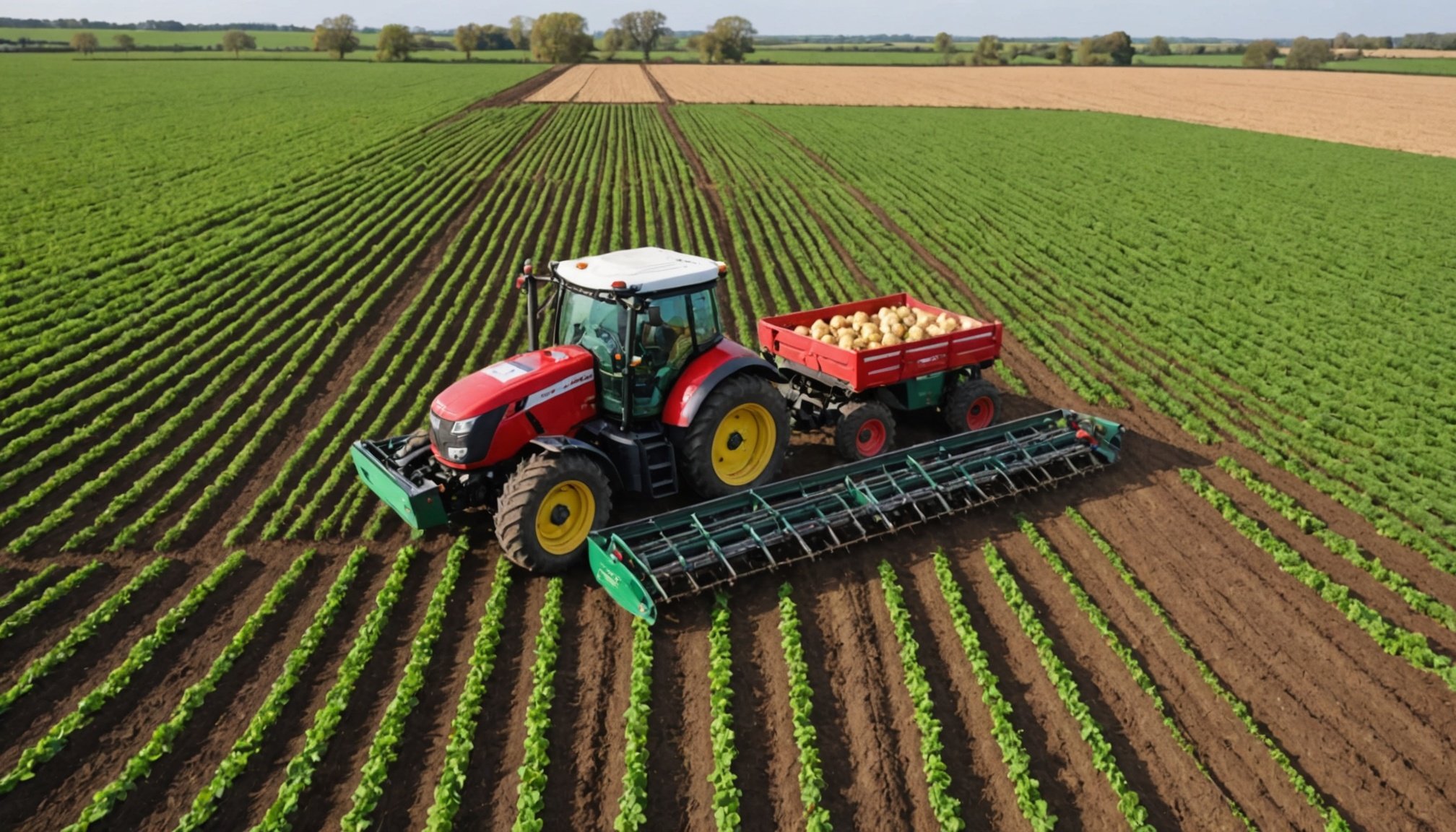Unveiling Revolutionary Innovations in Precision Agriculture: Transforming Potato Farming Across the UK
The Rise of Precision Agriculture in Potato Farming
Precision agriculture, often referred to as precision farming, is revolutionizing the way farmers cultivate and manage their crops, including potatoes. This approach leverages advanced technologies such as machine learning, real-time data analysis, and smart farming tools to optimize crop production, reduce environmental impact, and enhance food security.
In the UK, where potato farming is a significant sector, these innovations are particularly crucial. Here’s how new technologies are transforming potato farming:
In parallel : Captivating stories from asia: dive into diverse genres
Advanced Pathogen Detection
One of the groundbreaking innovations is the development of advanced pathogen detection systems. For instance, the PathoScout system, created in collaboration with Rothamsted Research, enables on-site pathogen detection within 60 minutes. This technology can detect pathogens like potato late blight, rusts, Septoria, and grape powdery mildew, reducing unnecessary spraying and lowering environmental harm. By minimizing fungicide use by 5-20% and increasing yields by 1-10%, this system supports ecological sustainability and enhances crop protection[1].
Genetic Engineering for Climate Resilience
Climate change is one of the most significant challenges facing agriculture today. To address this, scientists are engineering climate-resilient potatoes that can thrive under extreme heatwave conditions.
Also read : Revolutionizing urban living: the benefits of intelligent waste management systems in uk cities
The RIPE Project
The Realizing Increased Photosynthetic Efficiency (RIPE) project at the University of Illinois has made significant strides in this area. By introducing two new genes, glycolate dehydrogenase and malate synthase, into the potato’s DNA, the team has improved photosynthetic efficiency. This genetic modification helps the plant metabolize the toxin glycolate in the chloroplast, reducing the energy cost associated with photorespiration.
“We need to produce crops that can withstand more frequent and intense heatwave events if we are going to meet the population’s need for food in regions most at risk from reduced yields due to global warming,” said Katherine Meacham-Hensold, scientific project manager for RIPE. “The 30% increase in tuber mass observed in our field trials shows the promise of improving photosynthesis to enable climate-ready crops”[2][4].
Smart Farming Technologies
Smart farming technologies are at the forefront of precision agriculture, offering farmers a range of tools to optimize their farming practices.
Smart Soil Technology
KUHN FARM MACHINERY (UK) Ltd has introduced Smart Soil Technology (SST) integrated into their OPTIMER 6 and 7.5 metre independent disc cultivators. This technology ensures consistent working depth across uneven terrain through automatic adjustments using pressure and position sensors. The AUTO-LINE function keeps the machine aligned behind the tractor, adapting to slopes, soil types, and depth changes. This innovation results in uniform stubble ploughing with consistent depth and reduced overlaps, improving soil preparation and enhancing crop germination[1].
Compact Sprayers and Precision Chemical Injection
Martin Lishman Ltd is another company leading the way in precision agriculture. Their compact sprayers, available in various models, offer exceptional reliability and durability. These sprayers can be customized with factory-fitted options to meet specific farming needs. Additionally, the Smart-Inject system, designed to revolutionize agricultural spraying, allows for precise spot spraying by injecting chemicals directly into the diluted spray stream at the nozzle. This approach minimizes chemical usage, lowers costs, and significantly reduces environmental impact[1][3].
Data-Driven Decision Making
Data is a critical component of precision agriculture, enabling farmers to make informed decisions in real time.
HarvestEye Technology
HarvestEye is an innovative system that fits seamlessly onto harvesters, conveyors, or can be used as a handheld tool. Powered by advanced AI, it automatically counts, sizes, and analyzes produce, providing clear insights into marketable yield. This technology helps farmers build detailed size variability maps, uncover data on crop performance, and make smarter decisions that boost efficiency and profitability[5].
Sustainable Farming Practices
Sustainable farming practices are essential for the long-term health of the agricultural sector and the environment.
TuberLog and Soil Test Kits
Martin Lishman Ltd’s TuberLog electronic potato identifies damage points in harvesting and handling machinery, maximizing crop yields. The company also offers soil test kits that help farmers understand their soil’s composition, which is crucial for achieving high-quality yields. These tools are part of a broader commitment to sustainable farming, including initiatives such as installing solar panels, upgrading to efficient lighting, and introducing electric vehicles[3].
Future of Potato Farming
As we look to the future, it is clear that precision agriculture will continue to play a pivotal role in potato farming.
Key Innovations to Watch
Here are some key innovations that are set to transform the future of potato farming:
-
Advanced Pathogen Detection:
-
On-site pathogen detection within 60 minutes
-
Reduction in fungicide use by 5-20%
-
Increase in yields by 1-10%
-
Applications in pollen monitoring, hospital bacteria detection, and forensic analysis[1].
-
Genetic Engineering:
-
Introduction of genes to improve photosynthetic efficiency
-
30% increase in tuber mass under heatwave conditions
-
No impact on nutritional quality of the crop yield[2][4].
-
Smart Farming Technologies:
-
Smart Soil Technology for consistent soil preparation
-
AUTO-LINE function for adapting to terrain changes
-
Smart-Inject system for precise chemical application[1][3].
-
Data-Driven Decision Making:
-
Real-time data analysis using AI-powered tools like HarvestEye
-
Detailed size variability maps and crop performance data
-
Smarter decision-making for enhanced efficiency and profitability[5].
Practical Insights and Actionable Advice
For farmers looking to adopt these innovative technologies, here are some practical insights and actionable advice:
Embrace Technology Gradually
- Start by integrating one or two new technologies into your existing farming practices.
- Monitor the impact and adjust as necessary before scaling up.
Invest in Training
- Ensure that your team is well-trained in using the new technologies.
- Regularly update your skills to keep pace with the latest advancements.
Focus on Sustainability
- Implement sustainable farming practices such as using solar panels, efficient lighting, and electric vehicles.
- Use soil test kits and other tools to optimize soil health and reduce environmental impact.
Collaborate with Experts
- Work with research institutions and technology companies to stay updated on the latest innovations.
- Participate in field trials and provide feedback to help refine new technologies.
Precision agriculture is revolutionizing potato farming in the UK, offering a range of innovative solutions that enhance crop production, reduce environmental impact, and support sustainable farming practices. From advanced pathogen detection to genetic engineering for climate resilience, and from smart farming technologies to data-driven decision making, these innovations are paving the way for a more efficient, sustainable, and productive agricultural future.
As Don Ort, the Robert Emerson Professor of Plant Biology and Crop Sciences, noted, “Food security is not just about the amount of calories that can be produced but we must also consider the quality of the food.” With these new technologies, farmers can ensure both quantity and quality, meeting the food needs of a growing population while protecting the environment for future generations[2][4].
Table: Comparison of Key Innovations in Precision Agriculture for Potato Farming
| Innovation | Description | Benefits |
|---|---|---|
| PathoScout | On-site pathogen detection within 60 minutes | Reduces fungicide use by 5-20%, increases yields by 1-10% |
| RIPE Genetic Engineering | Introduction of genes to improve photosynthetic efficiency | 30% increase in tuber mass under heatwave conditions, no impact on nutritional quality |
| Smart Soil Technology | Consistent soil preparation and adaptation to terrain changes | Uniform stubble ploughing, improved soil health and crop germination |
| Smart-Inject | Precise chemical application at the nozzle | Minimizes chemical usage, lowers costs, reduces environmental impact |
| HarvestEye | Real-time data analysis using AI-powered tools | Detailed size variability maps, crop performance data, smarter decision-making |
| TuberLog | Identifies damage points in harvesting and handling machinery | Maximizes crop yields, reduces waste |
| Soil Test Kits | Helps farmers understand soil composition | Optimizes soil health, reduces environmental impact |
Detailed Bullet Point List: Steps to Implement Precision Agriculture in Potato Farming
-
Assess Current Practices:
-
Evaluate existing farming methods and identify areas for improvement.
-
Consider the specific challenges and opportunities in your region.
-
Choose the Right Technology:
-
Select technologies that align with your farming goals and resources.
-
Consult with experts and other farmers to get feedback on different technologies.
-
Invest in Training:
-
Ensure that your team is well-trained in using the new technologies.
-
Provide ongoing training to keep skills updated.
-
Integrate Technologies Gradually:
-
Start with one or two new technologies and monitor their impact.
-
Scale up gradually based on the results.
-
Focus on Sustainability:
-
Implement sustainable farming practices such as using renewable energy sources.
-
Use tools like soil test kits to optimize soil health.
-
Use Real-Time Data:
-
Utilize AI-powered tools like HarvestEye for real-time data analysis.
-
Make data-driven decisions to optimize crop production and reduce waste.
-
Collaborate with Experts:
-
Work with research institutions and technology companies to stay updated on the latest innovations.
-
Participate in field trials and provide feedback to help refine new technologies.
-
Monitor and Adjust:
-
Continuously monitor the impact of new technologies and adjust as necessary.
-
Be open to new innovations and willing to adapt to changing conditions.











